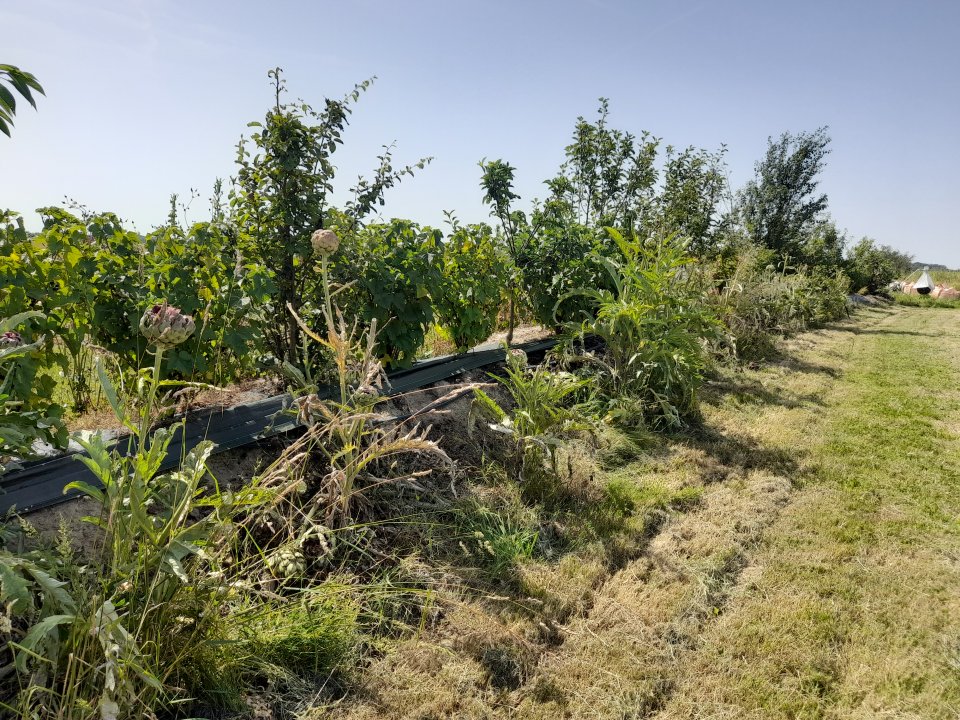
The project is located in the municipality of Maisdon-sur-Sèvre, in the touristic metropolitan area of Clisson, Loire-Atlantique. The site is situated in the historic Muscadet wine-growing area, which now has many abandoned vineyards, with urban sprawl gradually eating away at agricultural land. The soils of these abandoned vineyards have been impoverished by more than 20 years of conventional monocultural winegrowing. The Beau Soleil des Landes farm has made the transition to organic farming and is leading one of the few agroforestry projects in the Loire-Atlantique department. Its activity is divided between the extensive raising of about twenty dairy cows and egg-laying hens, and diverse market gardens partially processed on the farm (jams). The produce of the farm and other producers in the area are sold directly at the farm shop or to local organic shops and restaurants. The planted areas extend over a 7-ha site characterised by a soil that has been impoverished, polluted and compacted by 20 years of conventional agricultural practices. The adoption of agroecological practices, notably the planting of hedges, improves the infiltration of water and favours the proliferation of beneficial organisms, which in turn improve the resilience of the farm.
- For adapting to climate change : mitigate the effects of climate change through the creation of microclimates, improve the infiltration of rainwater and control runoff.
- For biodiversity : create conditions favouring the return of biodiversity and a refuge for local species.
- For the local area : integrate these developments in local added-value economic activities
Begun in 2018, the works consisted in :
- Creating 1 000 metres of mounds, fertilising and mulching, and planting 2348 trees and shrubs suited to the pedoclimatic context (including 248 agroforestry trees, 300 fruit bushes and 1000 berry bushes).
- Planting 200 linear metres of fruit trees and 600 linear metres of hedgerows; alternating two lines of fruit trees and one line of nitrogen-fixing trees over a surface area of 4L8 ha. The lines follow the contours manually determined using a laser measurement tool at night
- Deploying other green infrastructure for the management of runoff, in particular ponds, muddy areas and ditches, which proved to act as refuges for biodiversity and as carbon sinks.
- The works were carried out by means of participative worksites and maintenance is performed by several employees, notably through a mentoring system that puts the farm in contact with refugees. The replanted areas concerned approximately 5 % of the young plants, especially in the wetlands, where willow and poplar cuttings were preferred. The farm’s business model is fairly diversified, and includes renting out land for camping and hosting teleworkers.
BENEFITS REGARDING TARGETED ADAPTATION ISSUES
- Regenerating and stabilising the soil : the soil is structured and fertilised by the root systems of the trees and shrubs.
- Controlling runoff : trees assist the deep infiltration of rainwater and its filtration in the soil.
OTHER BENEFITS
- Sequestration of carbon.
- Enhancing the food sovereignty of the local area.
- Integration in local added-value economic activities (use of firewood, commercialisation through partners, fuelwood sector, etc.).
- Mitigating very high temperatures : enhanced shade to create cool areas on the farm.
BENEFITS FOR BIODIVERSITY
- Protecting the biodiversity of the farm from pollution and very high temperatures : using the windbreak effect of the trees to act as a barrier to pesticide residues and increase the shade provided to improve the well-being of farm animals.
- Creation of habitats propitious to wildlife : the hedges are a refuge for wildlife, notably beneficial organisms, and naturally fertilise the soil via their root systems
- Developing climate change adaptation; improving risk management and resilience
- Increase infiltration / Water storage
- Increasing infiltration
- Reduce drought risk
- Reduce flood risk
- Reduce run-off
- Reducing temperature at meso or micro scale
- Restoring ecosystems and their functions
- Increase Biodiversity
- Increase well-being
TECHNICAL ASPECTS AND PROJECT DESIGN
- Adapting to local conditions : the choice and mound-planting of tree species were determined by the hydromorphic situation, however maintenance proved complicated (more practical to work on the flat). Regular maintenance with a rotary slasher is required for the first three years.
- Innovating : using green fertiliser made from oats to depollute the soil.
- Seeking an economic balance : planting berry bushes provides additional income for the farm.
STAKEHOLDER COMMITMENT
- Benefiting from expert advice : the farm was assisted by local stakeholders (nurseries, associations, etc.) in the selection of tree species and farming practices.
- Getting involved in local production : the farm supplies its wood to the local area.
- Consulting with local decision makers : the farm can count on the support of the municipality.
MONITORING AND REPLICABILITY OF THE ACTION
- Assessment : the regular monitoring of species abundance by the LPO and indictors of soil and plant health by CDC Biodiversité enable the benefits of agroecological practices to be assessed scientifically.
- Replicability and influence : through its « introductions to self-sufficiency » and participative worksites organised throughout the year, the farm contributes to the dissemination of knowledge and the training of agroecological project leaders.
- Sustaining the project over time : its integration into the Nature 2050 programme will ensur
- « Trees for the Future » contest grant– Nature 2050
- Owner’s funds
Total budget : 16 650 €
Plus the cost of sustaining and monitoring the project until 2050, to be covered by the Beau Soleil des Landes farm and CDC Biodiversité.
- Claire Gallon https://www.beausoleildeslandes.com/contact/
- Nature 2050 – Programme & Fonds
nature2050@cdc-biodiversite.fr
- 2. Zero Hunger
- 6. Clean Water and Sanitation
- 12. Responsible Consumption and Production
- 13. Climate Action
- 15. Life On Land
